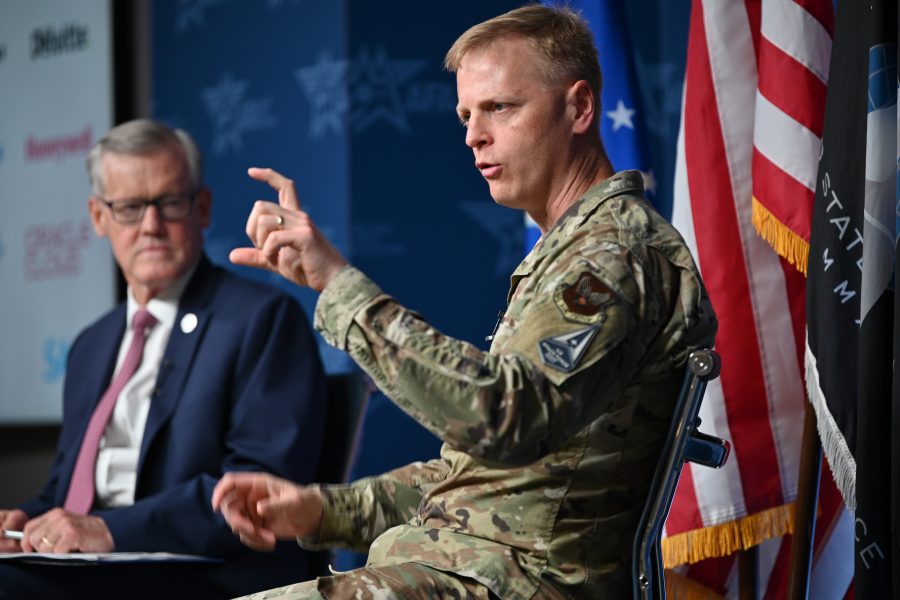Coordination across the services is at a historic high when it comes to the Pentagon’s plans to connect sensors and shooters from every domain around the globe—but there will still be setbacks in the ambitious effort, Brig. Gen. Luke C.G. Cropsey, the Department of the Air Force’s Integrating Program Executive Officer for Command, Control, Communications, and Battle Management, said July 10.
The key for the Air Force and the other services, Cropsey said, will be to not let those setbacks discourage them from pushing forward with their vision of a future networked battlefield where sensors in the air, on land, at sea, and in space can seamlessly share data among weapons systems: Combined Joint All Domain Command and Control (CJADC2).
“We got a lot of great Americans out there across this entire department that have fundamentally grasped the need and the requirement to figure this thing out,” Cropsey said at an AFA Warfighters in Action event. “I think we’re in a unique juncture in history right now when it comes to the pervasiveness with which the need to do something different exists across the entire department. It doesn’t matter whether I’m talking air, doesn’t matter if I’m talking space. If I go to the Navy and I talk to the Army, everybody’s on the same sheet of music when it comes to this topic. It’s crazy. I’ve never seen as much alignment in the last 30 years that I’ve been doing this.”
Cropsey also said he has “phenomenal senior leadership support” from the likes of Air Force Secretary Frank Kendall that has helped empower his team, which is working on the the Department of the Air Force’s contribution to CJADC2, traditionally known as the Advanced Battle Management System.
“We don’t have a talent problem,” Cropsey said. “I got a bunch of unicorns in the stable.”
“I get to see the Secretary every 90 days and give them an update on what’s working and what isn’t—and it’s surprising how many things start working,” he added.
But there is still a long way to go for the Pentagon to design and implement CJADC2 and ABMS efforts—and there will be stumbles along the way.
“We got people that have the talent to do it and we’ve got leadership that are willing to break a few things in the process,” Cropsey said. “We’ll get it exactly wrong, all right? I’m the first person to tell you I’ve got it exactly wrong, but we’re generally headed in the right direction.”
Progress on ABMS and CJADC2, which officials say is needed to shorten the kill chain from hours to seconds against China and Russia rather than less technologically advanced Middle Eastern foes, has been deliberate at best—not helped by the fact that even explaining the concept, never mind getting it to work seamlessly, is a challenge.
“The classic acquisition model typically involves nouns,” Cropsey explained, referring to traditional programs such as aircraft, bombs, and satellites. With CJADC2 and ABMS, the Department of the Air Force is seeking to buy “decision advantage” over its adversaries.
“When you start talking about that, people’s brains start to turning into mush,” Cropsey said. “I can’t feel it, touch it, see it.”
When Kendall named Cropsey to his position in September 2022, he said it was the hardest acquisition job he had given anyone—no small feat as Kendall previously served as the Department of Defense’s top weapons buyer from 2012-2017. Kendall made “operationally-focused” ABMS one of his seven Operational Imperatives for the Department of the Air Force, noting he wanted to create real-world capability, instead of demonstrating concepts that bring no tangible benefit to the fight.
“It’s a challenge that he talks about is the fact that we didn’t actually have a blueprint” for CJADC2, Cropsey said. “If you turn engineers loose without supervision, they will absolutely, guaranteed find a solution for which you have no problem. So our first order of business was to make sure that we were solving a real problem that mattered fundamentally.”
Cropsey likened creating ABMS and CJADC2 to building a house. The network will be filled with many “bricks.”
“If a brick doesn’t fit the design, you need to come back and tell me, ‘Hey, we need to quit working on that,’ and shift the effort to something else that’s actually going to get us where we need to go,” Cropsey said.
Cropsey said he wants to solve “near-term common sense” problems as he builds out his “longer-term blueprint.”
